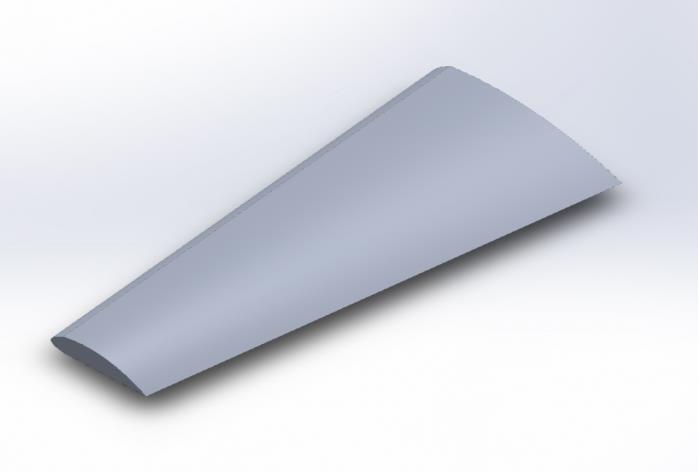Aerodynamic Characteristics of Forward Swept Wing in Subsonic Speed
DOI:
https://doi.org/10.37934/cfdl.16.5.18Keywords:
Forward swept wing, subsonic speed, lift coefficient, drag coefficient, moment coefficient, aerodynamic stallAbstract
A forward swept wing was designed to use for a supersonic aircraft. Its aerodynamic characteristics were studied through experiments and numerical simulations which excluded the subsonic speed condition. For this paper aims to explore the aerodynamic characteristics of the forward swept wing in the range of subsonic speed by using a computational fluid dynamics method. In simulation, the airfoil shape of the wing model was NACA 3412. It was varied in both swept angle and angle of attack. The airspeed was given constant at 50 m/s. The simulation results indicate that the forward swept wing model is suitable for the aerobatic aircraft because lift coefficient and the stall angle of the forward swept wing model is higher than the non-swept wing model. Moreover, the aerodynamic stall of the forward swept wing occurs at the wing root which makes the aircraft able to maintain the controllability of the aileron surface at high angle of attack. However, the aircraft with forward swept wing model tends to consume more energy as compared with non-swept wing model. Because the maximum lift to drag ratio of the forward swept wing is less than the non-swept wing. Non-swept wing model has the maximum lift to drag ratio of 8.76 at the angle of attack 2°. While the forward swept wing 35° provides the maximum lift to drag ratio of 7.47 at the angle of attack 6°.
Downloads
References
Breitsamter, Christian, and Boris Laschka. "Vortical flowfield structure at forward swept-wing configurations." Journal of aircraft 38, no. 2 (2001): 193-207. https://doi.org/10.2514/2.2758
Inglezakis, Dimitrios A., Georgios N. Lygidakis, and Ioannis K. Nikolos. "Flow Analysis of the M151 Aircraft Model Using the Academic CFD Code Galatea." In ASME International Mechanical Engineering Congress and Exposition, vol. 58349, p. V001T03A003. American Society of Mechanical Engineers, 2017. https://doi.org/10.1115/IMECE2017-70208
Ma, Binlin, Xinbing Su, Taorui Li, and Ning Wang. "Numerical Study on Influence of Canard on Static Aeroelastic Characteristics of Forward-Swept Wing." In 2017 International Conference on Mechanical, Electronic, Control and Automation Engineering (MECAE 2017), pp. 379-385. Atlantis Press, 2017. https://doi.org/10.2991/mecae-17.2017.72
Setoguchi, Nao, and Masahiro Kanazaki. "Low-speed and high angle of attack aerodynamic characteristics of supersonic business jet with forward swept wing." In AIAA Scitech 2020 Forum, p. 0534. 2020. https://doi.org/10.2514/6.2020-0534
Yen, Shun C., and Lung-C. Huang. "Reynolds number effects on flow characteristics and aerodynamic performances of a swept-back wing." Aerospace science and technology 15, no. 3 (2011): 155-164. https://doi.org/10.1016/j.ast.2010.10.005
Xinbing, S. U., Jiang Wen, Zhao Xiwei, and Zhang Junyi. "Research on Aerodynamic Characteristics of Forward-swept Wing with Inclined Basic Airfoil." In Journal of Physics: Conference Series, vol. 1605, no. 1, p. 012075. IOP Publishing, 2020. https://doi.org/10.1088/1742-6596/1605/1/012075
Lundvall, Fredrik, William Yachnin, and Julien Perroud. "Forward-swept Wings." In TMAL02 Expert Conference, vol. 8, no. 4, pp. 11-13. 2019.
Rongrong, Xue, Ye Zhengyin, Ye Kun, and Wang Gang. "Composite material structure optimization design and aeroelastic analysis on forward swept wing." Proceedings of the Institution of Mechanical Engineers, Part G: Journal of Aerospace Engineering 233, no. 13 (2019): 4679-4695. https://doi.org/10.1177/0954410018807810
Guoqing, Zhang, Yang Shuxing, and Xu Yong. "Investigation of vortex interaction in canard-FSW configurations based on the numerical wind tunnel method." Chinese Journal of Aeronautics 23, no. 3 (2010): 312-319. https://doi.org/10.1016/S1000-9361(09)60221-1
Zhang, G. Q., S. C. M. Yu, A. Chien, and S. X. Yang. "Aerodynamic characteristics of canard-forward swept wing aircraft configurations." Journal of aircraft 50, no. 2 (2013): 378-387. https://doi.org/10.2514/1.C031740
Jaffar Syed Mohamed AliM. Mubin Saleh. "Experimental and Numerical Study on the Aerodynamics and Stability Characteristics of a Canard Aircraft." Journal of Advanced Research in Fluid Mechanics and Thermal Sciences 53, no. 2 (2020): 165-174.
Wang, Ning, Xinbing Su, Binlin Ma, and Xiaofei Zhang. "Numerical Study on Influence of Canard Height on Aeroelastic Behavior of Forward-Swept Wing." In IOP Conference Series: Materials Science and Engineering, vol. 452, no. 4, p. 042048. IOP Publishing, 2018. https://doi.org/10.1088/1757-899X/452/4/042048
Wibowo, Setyawan Bekti, Sutrisno Sutrisno, and Tri Agung Rohmat. "The influence of canard position on aerodynamic characteristics of aircraft in delaying stall conditions." In AIP Conference Proceedings, vol. 2021, no. 1. AIP Publishing, 2018. https://doi.org/10.1063/1.5062792
Lei, Juanmian, Shuai Zhao, and Suozhu Wang. "Numerical study of aerodynamic characteristics of FSW aircraft with different wing positions under supersonic condition." Chinese Journal of Aeronautics 29, no. 4 (2016): 914-923. https://doi.org/10.1016/j.cja.2016.06.006
J.D. Anderson, Fundamentals of Aerodynamics. 2010: McGraw-Hill Education.
Chiplunkar, Viren, Rahul Gujar, Abhir Adiverekar, Rahul Kulkarni, and Amey Thonge. "Computational fluid dynamics analysis for an active rear-wing design to improve cornering speed for a high-performance car." Materials Today: Proceedings 77 (2023): 887-896. https://doi.org/10.1016/j.matpr.2022.12.040
Jahangardy, Y., R. Madoliat, N. M. Nouri, and M. Zeinali. "An inverse problem for estimation of the drag and lift coefficients of wing sections." European Journal of Mechanics-B/Fluids 65 (2017): 160-167. https://doi.org/10.1016/j.euromechflu.2017.03.005
Anuar, Kaspul, and Agung Soegihin. "Aerodynamic Analysis of Unnamed Aerial Vehicle Serindit V-2 Using Computational Fluid Dynamics." Journal of Advanced Research in Fluid Mechanics and Thermal Sciences 93, no. 1 (2022): 83-93. https://doi.org/10.37934/arfmts.93.1.8393




























